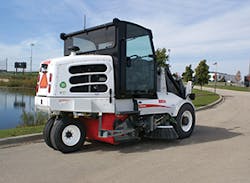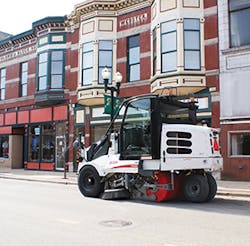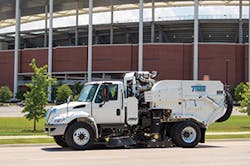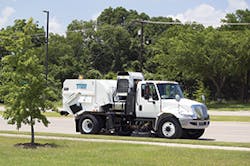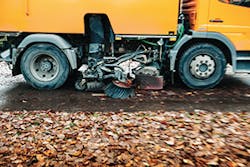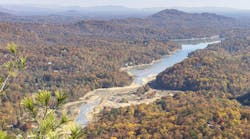Plaquemine, LA, is located about 18 miles west of Baton Rouge. The city has a population of about 8,000. Plaquemine’s director of Public Works, Richard Alleman, directs the city’s street sweeping operation.
Alleman says that the street sweepers are popular with the residents of Plaquemine. “My public is spoiled. They love the street sweepers. And when they call and ask ‘Can they come back?’ we’ll send them back.”
Alleman is a great believer in educating the public about street sweeping and other ways to protect a community’s waters. “Education is key. The more [educational materials and signage] we put out for the public, the better they will understand what we’re doing.
“You’ll find the public will work with you if they understand why,” explains Alleman. He cites an effective example of public outreach that his crew performed. “Three years ago, we did a cleanup along a certain section of Plaquemine,” he recalls. “Then, we actually put what we picked up on display along the main highway with a big sign that read, ‘This is what you put in Bayou Plaquemine.’”
Public reaction was strong. “We got more comments—a very positive response. People said, ‘We shouldn’t leave litter on the banks of the bayou. We shouldn’t throw anything into the bayou.’ Littering went way down.”
Alleman sees street sweeping as essential and economical. “Not sweeping, to me, is just crazy.”
He notes that some smaller towns near Plaquemine don’t have their streets swept. “They have problems with their drainage systems and flooding. [When they ask for help] I help them, and I tell them, ‘The best tool you can have is a street sweeper. If you sweep, you won’t have these problems. Drains get clogged up because debris won’t stay along the curb.’”
About three months ago, one of those towns bought a used street sweeper, he says. “The public works director recently called me and said, ‘You were right. We don’t have the flooding we used to have.’”
He says engineers have told him that “our drainage system is so clean because of our street sweeping. Whatever goes into those storm drains has the potential to end up in the bayou.”
Bayou Plaquemine runs from the Mississippi River to the Intracoastal Waterway. It is about 7 miles long and 350 feet across. “Water is currently blocked from going into the Mississippi River,” explains Alleman. “There used to be a lock system, but when the Intracoastal Waterway became functional, the locks were closed down.”
Next to this major water feature is Bayou Park. It’s located in the city’s garden district, which has a number of historic homes.
“Out of five days a week, Bayou Road gets swept about three days,” says Alleman. That frequency is not solely to favor the residents of this section of town. City employees cut grass on six of the street sweeping routes, and the sweeping has to be done after the grass is cut. To reach an old incineration yard where the debris is dumped, the sweeper operator has to go across town frequently using Bayou Road. Alleman has told his crew members, “If you’re going from point A to point B, I want you to sweep along the way.”
The street sweepers run “52 weeks out of the year, five days a week,” says Alleman. “We do very little sweeping at night.”
He notes, “In a small town, there’s no need to post sweeping schedules. The residents know when we’re coming. We start on one side of town and finish on the other side. We go behind the trash trucks a day later.”
Plaquemine has “in the neighborhood of 55 miles of streets to sweep. Every street in the city is swept at least once a week. Some are swept twice a week, especially in the garden district and the historic district.”
Areas with lots of trees get more attention seasonally. Predominant tree species include oak, pine, and cypress.
“We have some types of oaks that drop their leaves in the spring, and others that shed leaves in the fall,” explains Alleman.
Plaquemine has two drivers who operate the city’s two sweepers. Alleman’s favorite sweeper is the Stewart-Amos Galaxy R-6 model, a regenerative-air sweeper.
“I plan on buying another Stewart-Amos within the next fiscal year. I’m highly impressed with their machinery,” he says. “We looked at the sweeper for two years before we decided to buy it.”
Alleman mentions several reasons for his preference. “It’s smaller. It fits my streets very well, with a short turning range. It goes down older streets very well.”
While Plaquemine is mostly flat and has no major geographical obstacles, it has a couple of unusual challenges for street sweeping. These challenges, which stem from Louisiana’s cultural and social history, are the two local Mardi Gras parades. Like the big celebration in New Orleans, these parades are held just before Lent begins. Streets and curbs are strewn with hundreds of strands of plastic and lightweight aluminum beads, most of them in the traditional Mardi Gras colors of gold, purple, and green. Revelers on the floats toss strands of these beads and other trinkets to the enthusiastic crowds that line the parade routes. These so-called “throws” await the street sweepers on the morning after the parade.
“People can only carry so many items, even when they are lightweight beads, so they just leave what they don’t want to take home. There are so many beads, we can pick them up with shovels,” explains Alleman.
The litter left behind includes some of the usual food wrappers and beverage cups, but “90% of it is beads,” notes Alleman.
The nighttime parade, which started four years ago, features 30 decorated floats, all with people aboard throwing out “treasures.” It is held under the sponsorship of a local social club, the Krewe of Comogo. (The New Orleans social clubs that decorate floats for the big Mardi Gras are also known as krewes.)
The parade has become very popular, drawing out-of-town visitors. “Our population almost tripled [on parade night]. But the machine does a wonderful job picking up litter immediately after the parade.”
The second parade is held in another section of Plaquemine. It takes place two days before the nighttime parade.
“People eat and cook, especially barbecue, all along the route,” says Alleman. “The throws from this parade are a lot of paper—paper plates and napkins, Styrofoam.”
The parades used to be real headaches for the street sweeping operation. “The older sweeper we had was making a bigger mess than it was cleaning up,” recalls Alleman. But fortunately, the new machine has made cleanup easier.
The street sweeping crew has developed an efficient method to clean the streets and curbs of parade litter. They blow beads and other litter from the front yards to the curb, where it is easily swept up. The paper debris from the second parade is already along the curbs and streets. The sweeper’s vacuum pad blowers “blow everything to the middle of the street for sweeping up. It’s a heck of a lot faster,” says Alleman.
“The residents are, for the most part, good about not putting leaves into the street.” More problems arise when residents outsource lawn-mowing to contractors. “They blow grass into the roads. The homeowners know better, but they hire someone who doesn’t know [not to do this].”
Plaquemine has about 560 catch basins. “95% of the time, the Stewart-Amos sweeper is used to clean them,” Alleman says. “With the vacuum system on it, there’s enough suction to clean the catch basins.”
A few shallow catch basins are cleaned with shovels, but most of them are 3 to 6 feet deep. “That’s where the Stewart-Amos really comes into play. It loosens the dirt in the bottom, and then the operator turns on the vacuum.”
Catch basins are cleaned on a separate schedule from street sweeping. Most of them are located in the older sections of town that have matured leaves.
Generally speaking, “I start the morning sweeping and then have the driver spend two hours a day on the catch basins,” says Alleman.
He hasn’t made any real changes in Plaquemine’s street sweeping operation in recent years, he says, “except for one thing. I’ve been more consistent to keep up with things. Once I put my guy on the Stewart-Amos, which is 95% of his time, that keeps the streets a lot cleaner. I used to have to have a man sweeping at night, but not anymore.”
North Bergen, NJ
Just across the Hudson River from Manhattan, between the George Washington Bridge and the Lincoln and Holland Tunnels, is the city of North Bergen, NJ. Almost in the shadows of where the Twin Towers stood, North Bergen lost residents in the terrorist attacks of September 11, 2001.
It’s a densely populated urban area that measures almost 6 square miles. North Bergen has 64.7 miles of streets to clean.
“The sweepers run just in the daytime, four sweepers per day, with a crew of eight men,” says John Shaw, superintendent of Public Works for the city. “A blower goes along with each sweeper to blow trash out from under parked cars.”
Two sweepers operate on Saturday and Sunday. They clean the downtown commercial areas, starting at 7:00 a.m. Every street in North Bergen is swept twice per week. Commercial areas are swept four times per week.
Like other cities that experience winter weather, North Bergen’s sweeping is seasonal. It is suspended from December to March. Any sweeping of the streets during this period is generally done with a shovel or a broom.
“Our guys concentrate on snow removal then, but if there’s a decent day in winter, we put out the sweepers,” explains Shaw.
All eight of North Bergen’s sweepers are from Tymco. They are all regenerative-air/vacuum model 600s.
Shaw says that he inherited the Tymco 600s when he took his present position about five years ago. “I did buy one sweeper last year, and it’s a 600, too,” he says.
He adds that the Tymco 600s are “good basic sweepers—two brooms, one on each side of the vacuum. We like the sweepers’ strong suction for the leaves.”
North Bergen presents two challenges for street sweeping. The first is its hilly terrain. “We’ve been told that our town is the second hilliest in the US, per capita. The hills go from 5th Street to 92nd Street,” he says.
The second challenge for street sweeping in North Bergen is the parked cars on the streets—lots of tightly parked cars. “Our population is about 70,000, so parking is at a premium,” he notes. “We do allow cars to be pulled in [to empty parking spaces] right behind the sweepers.”
Shaw says that public reaction to street sweeping “is good, even though we give out summonses if cars are parked along our routes. We don’t enforce the no-parking rule in the winter. We put out advance notices, posting on our website and Facebook page that street sweeping is suspended.”
There are permanent signs that indicate sweeping days and hours for each street. When the weather is warm enough for sweeping, residents are not supposed to park there during sweeping hours. The department’s website and Facebook page let them know exactly when sweeping will resume.
Shaw says that street sweeping accounts for approximately 10–15% of the operating budget for North Bergen’s Public Works Department, and that “Trash collection is larger.”
North Bergen doesn’t have any streets with permeable paving. One older red brick road, dating back to the early years of the city, requires extra care from sweepers.
Tymco’s Model 600 sweeper
“We can barely run a snow plow down it. We have to keep the plow set higher so it won’t pull the bricks out,” says Shaw.
North Bergen has more than 3,000 catch basins. Shaw says the basins are cleaned “once every two years, more often if needed or if they’re flooded or we get complaints about them.”
Catch basin cleaning is done with the aid of two Vac-Con trucks and a 2100 Vactor truck. An older clam digger is also used to get out debris for the vacuums to remove.
Englewood, CO
Englewood, CO, is considered part of the Denver metropolitan area. The city has 121 centerline miles to be swept and 334 lane miles.
“We sweep when people can go and when the weather allows. We have no set schedule,” explains Larry Nimmo, right-of-way services manager for the City of Englewood. “We’ve just started sweeping our downtown area early every Friday morning.” He has considered implementing a set schedule, “but that would mean adding a third sweeper and another employee, and funds have not been available,” he says.
The street sweeping crew has four members. Only one person is needed per sweeper during daylight hours. During leaf season, “I put one sweeper with a truck because the sweeper fills up in seven to ten minutes,” he says. The sweeper’s load is dumped into the truck so that the sweeper can keep cleaning the streets. The truck then takes its load of leaves to the dumping area. Nimmo says that Englewood has lots of trees, particularly cottonwoods and elms.
Terrain isn’t very challenging. “Englewood is the first suburb south of Denver. We have hills, but not mountains.”
Englewood’s streets are laid out in a grid system. Nimmo says this pattern makes it very convenient for the sweepers to move from area to area.
Englewood has two sweepers, and both are Pelicans made by Elgin. These three-wheeled mechanical broom sweepers are especially suited for cleaning in narrow streets and congested areas.
Elgin’s Pelican is also available in an alternative fuel version. Another option is a waterless dust control sweeper.
Nimmo likes “how well they handle between parked cars. They have a small turning radius.”
He says the biggest change that his department has made concerns deicing practices. “We used to use sand and salt on the roads in winter. We had to sweep that up within three or four days and used to have three sweepers. Since about 2008, we switched to Ice Slicer, so we don’t have to sweep as much.”
Ice Slicer is a natural product made by Redmond Minerals in Utah. Nimmo says that many of the Denver-area municipalities are now using the product on their roads. “It was a regional air quality issue. Denver sits in a valley, so we can get inversions. Cars would run over the salt and sand, mashing it down, and dust would accumulate. With the inversion, it would just hang in the air,” he explains.
Nimmo says that sometimes there are problems with parked cars, but he thinks the residents appreciate the street sweeping. “Every once in a while, we get compliments,” he notes. Catch basins in Englewood are cleaned by the utilities department using Vactor trucks.
The street sweepers clean the tops of the basins.
Odessa, TX
Odessa, TX, is about 530 miles northwest of Houston in west Texas. The city’s estimated population in 2015 was 159,436.
“The entire city gets swept every month. Some streets are done twice a month, such as residential. Our downtown area is swept at least three times a month, with no night sweeping,” says Danny Garcia, superintendent of the Odessa Streets Department.
Four operators drive the department’s five sweepers. Odessa has 490 miles of streets to keep clean.
The land is mostly flat. “Some streets are crowned. That creates a lot of debris on the curbs, especially when it rains. That slows the sweeper down, or sometimes it has to make an extra pass,” says Garcia.
If the debris is particularly heavy, perhaps from a washout, “we pick up stuff with a backhoe. We don’t want to tear up a sweeper.” Another solution is to make three or four passes over the area. “It’s better to go with a lighter load than to ruin a sweeper,” cautions Garcia.
Garcia says the reaction his crew receives from residents of Odessa is positive. “They love it! They call if the sweeper has not yet made it that month [to their street]. We have more calls from residents than from business owners.”
Odessa’s climate means that the sweepers are in operation year-round. “We rarely get snow,” says Garcia. “Sometimes the roads freeze up. Then we go out and apply sand and deicer.”
He likes the department’s new A7 Tornado Regenerative Air Sweeper from Schwarze Industries. “We’ve been trying it out for six months and it’s been perfectly satisfactory.”
One of the A7 Tornado’s features Garcia appreciates is its movable gutter broom. “When you come to a railroad crossing, you can pick up the gutter broom to cross the track. Then just push a button and it goes back to its original position,” he explains.
He notes, “We added a broom to the sweeper. It goes all the way to the middle. It will swing inward and sweep the middle of the street. That’s helpful.”
The Odessa street sweeper drivers pick up grass clippings and leaves that people aren’t supposed to blow into the street but do. Predominant tree species include mulberry, Bradford pear, and oak.
“The only obstacles the drivers encounter are tree limbs that are way too low. We have an ordinance against that, so we send out notices that residents have to trim their trees,” he says.
Catch basins in Odessa are cleaned by sweepers that are equipped with vacuums. “We check catch basins after a rain.”
Clearer air, cleaner water—there is no question that street sweeping benefits the residents of every community where it is implemented. As the mentioned profiles indicate, more of those residents appreciate the street sweeping crews’ work.

